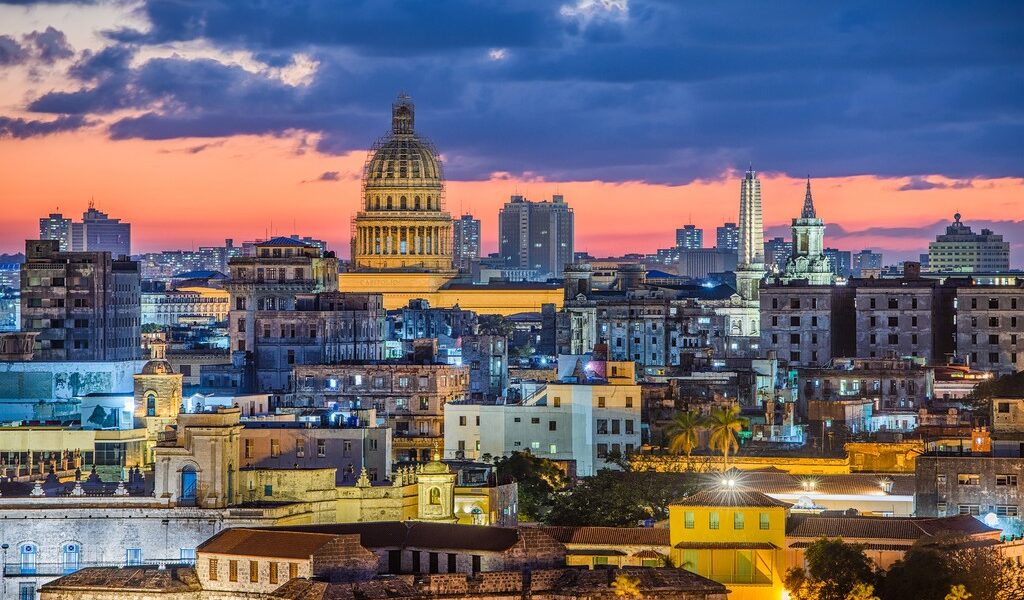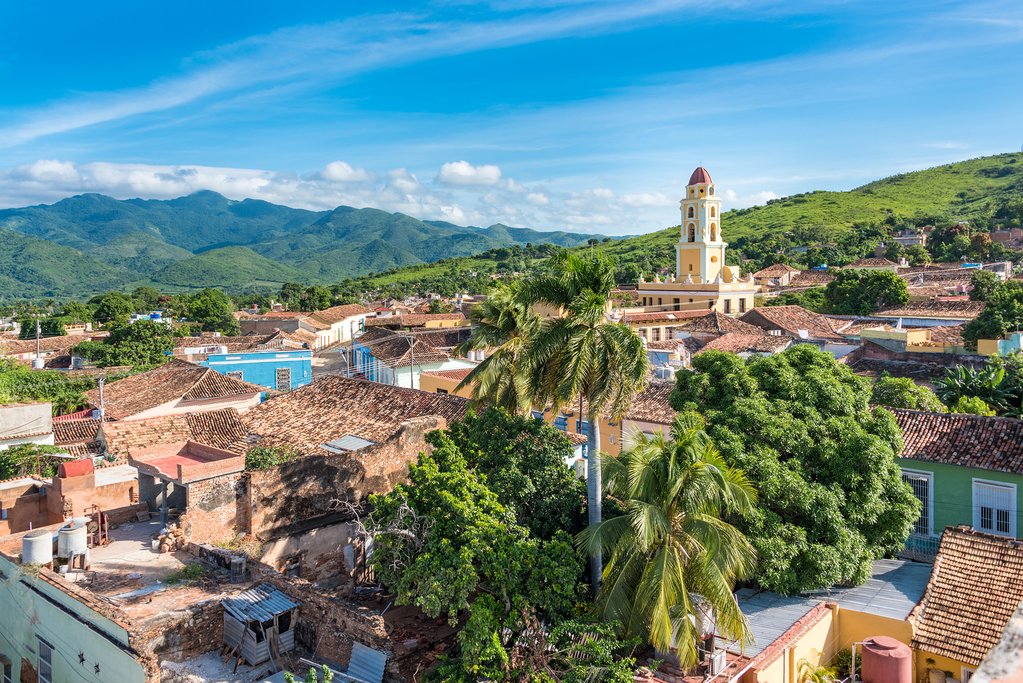
Cuba is a big island, boasting a wide range of scenery, sights, and activities. Whether you plan to sample the rich coffee of Sierra Escambray, dance the night away in Havana, or even follow the footsteps of Che Guevara down the revolutionary trail, every traveler will be able to find their own slice of Cuba – read on to find out which one is perfect for you.
Okay, here is the reworded travel content with a strictly higher word count than the original 2032 words, ensuring that all place names are retained, and website URLs are removed. The content is expanded with more descriptive language and details to meet the word count requirement.
Highlights
- Embark on a classic car cruise around Havana and delve into the world of Cuban cigars with a tour of a cigar factory
- Saddle up for a memorable horseback ride through the picturesque tobacco farms of Viñales, followed by an adventurous exploration of its captivating caves
- Trek through the verdant trails of the Sierra Escambray, discovering hidden coffee farms and cascading waterfalls along the way
- Immerse yourself in the vibrant and captivating Afro-Cuban culture that permeates every corner of Santiago de Cuba
#1 Havana
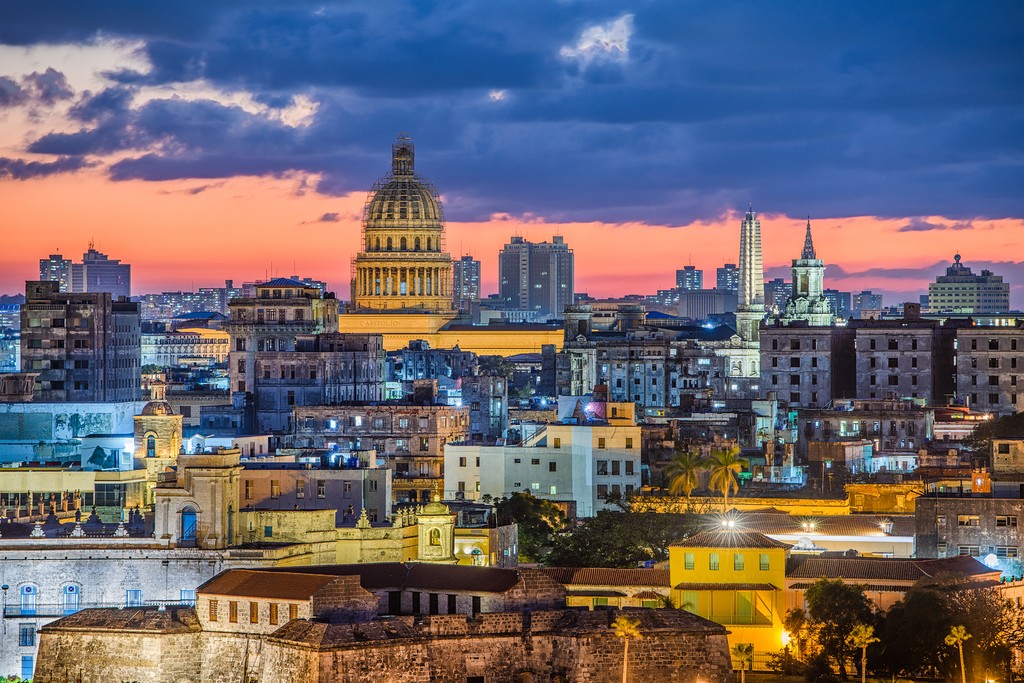
Havana, a city steeped in history and brimming with vibrant energy, was founded in 1519 on the western edge of a breathtaking bay. It stands as one of the most remarkable and historically significant cities in the New World. Each district within Havana possesses its own unique character and distinct atmosphere, showcasing an astonishing array of architectural styles that span centuries. From the grandeur of classical colonial mansions to the elegance of Art Nouveau and the sleek lines of Modernist structures, Havana is a visual feast for architecture enthusiasts. To truly appreciate all that Havana has to offer, plan to spend at least three days exploring its captivating streets and immersing yourself in its rich culture. Even a week might not feel like enough time to uncover all of its hidden gems and experience its myriad attractions. Three main districts stand out as essential destinations for any visitor: Habana Vieja, Centro Habana, and Vedado.
The most logical starting point for your Havana adventure is Habana Vieja (Old Havana), a UNESCO World Heritage site that exudes old-world charm and historical significance. Wander through its beautifully restored cobblestone plazas, marvel at the centuries-old castles and palaces that stand as testaments to Havana’s rich past, and discover dozens of other intriguing sites that will transport you back in time. On Habana Vieja’s western fringe, take a leisurely stroll around Parque Central and along the Prado, a sweeping, tree-shaded boulevard that gracefully descends towards the Atlantic shoreline. Don’t miss the opportunity to visit iconic landmarks such as the majestic Capitolio, a replica of the US Capitol Building, and the exquisite baroque-style Gran Teatro, a stunning architectural masterpiece that hosts world-class performances. Nearby, you’ll find the Museo de la Revolución, housed in the former presidential palace of dictator Fulgencio Batista, offering a fascinating glimpse into Cuba’s revolutionary history. Adjacent to the Museo de la Revolución is the Museo de Bellas Artes, displaying an impressive collection of artwork spanning from the colonial era to the present day.
Havana’s gritty street life comes alive in the densely populated Centro Habana, located just west of Habana Vieja. While formal tourist sites may be less abundant in this district, Centro Habana offers a raw and authentic glimpse into the daily lives of Cubans. It’s also home to some of Havana’s finest paladares, privately owned restaurants that offer delicious and affordable Cuban cuisine. A visit to Havana is incomplete without a stroll along the superbly scenic Malecón seafront boulevard, a vibrant gathering place where Cubans and tourists alike come to socialize, enjoy the ocean breeze, and soak in the lively atmosphere. On weekends, immerse yourself in the infectious rhythms of Afro-Cuban music and dance at Callejón de Hamel, also known as “Salvador’s Alley,” a colorful and vibrant street art project that celebrates Afro-Cuban culture.
Further west lies Vedado, a sprawling and airy district characterized by its wide, tree-shaded boulevards and grandiose mansions that were built in the early 20th century. Vedado is renowned for its vibrant nightlife, with many of Havana’s best nightclubs located within its boundaries. Step back in time with a visit to mobster-era hotels that still retain their original charm and allure, such as the iconic Hotel Nacional, the Modernist Hotel Habana Libre, and the glamorous Hotel Riviera. Explore the sprawling campus of the Universidad de la Habana, one of Cuba’s most prestigious universities, and wander through the astonishing Cementerio Colón necropolis, a city of the dead adorned with elaborate sculptures and mausoleums. And, of course, indulge in a sweet treat with the locals at Coppelia Park, Havana’s beloved ice cream parlor.
The activities in Havana are truly countless, ensuring that every visitor can find something to suit their interests. Delve into the world of Cuban cigars with a visit to a cigar factory, where you can witness the intricate process of cigar making from start to finish. Experience the glitz and glamour of the Tropicana outdoor cabaret, a legendary Havana institution that showcases dazzling performances of music, dance, and Cuban culture. Explore the Museo Ernest Hemingway, located in the author’s former home outside the city, and gain insights into the life and work of this literary icon.
#2 Viñales
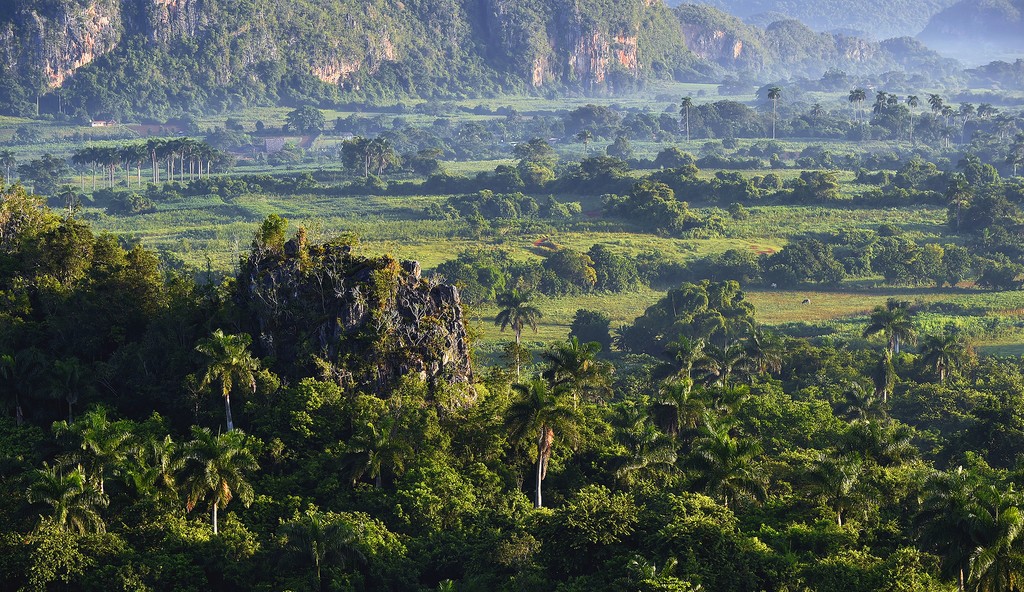
A scenic three-hour drive west of Havana will transport you to the Valle de Viñales, a breathtaking valley that boasts some of Cuba’s most spectacular scenery. Nestled in the heart of the Sierra de Los Órganos, the valley is surrounded by majestic mogotes, free-standing limestone formations that rise dramatically from the valley floor, creating a surreal and awe-inspiring landscape. The Valle de Viñales is also the heartland of Cuban tobacco farming, where traditional methods are still practiced. Witness ox-drawn plows tilling the ruddy fields, framed by towering royal palms that add to the valley’s idyllic charm. Thatched tobacco drying sheds dot the landscape, and a sense of tranquility pervades the air, transporting visitors back in time to a bygone era.
In recent years, the Valle de Viñales has emerged as a hub for active adventures, offering a range of thrilling activities for outdoor enthusiasts. Embark on an ATV tour through the valley’s rugged terrain, soar through the air on a ziplining adventure, or explore the valley’s hidden caves and grottos. While three hotels cater primarily to tour groups, hundreds of charming casas particulares (private B&Bs) offer more intimate and authentic accommodations, allowing you to experience the warmth and hospitality of the local community.
#3 Península de Zapata
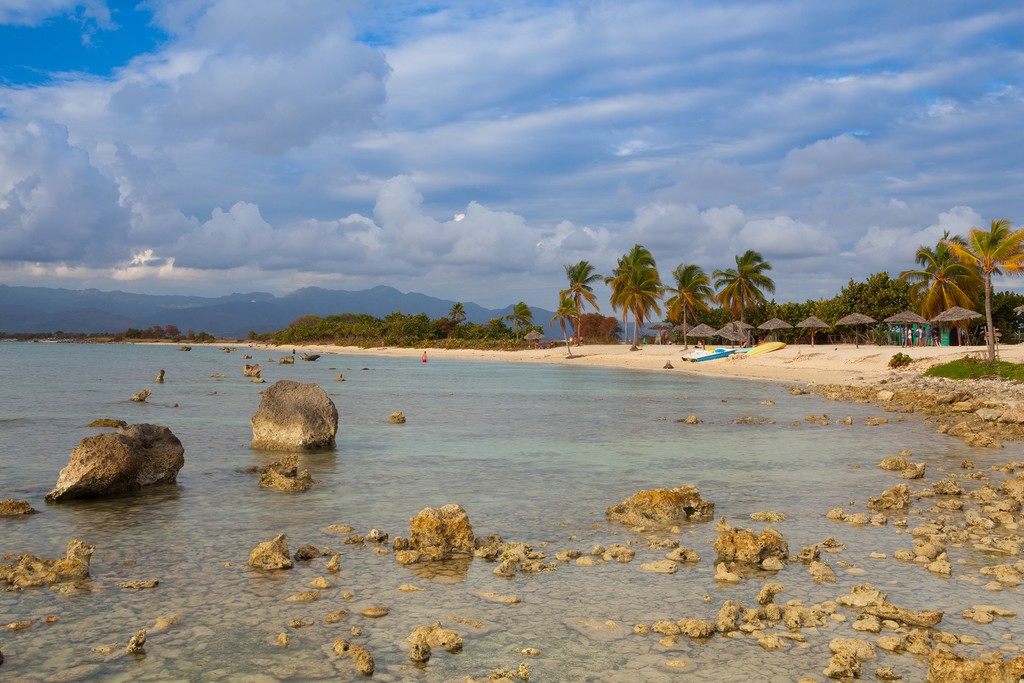
A two-hour drive east along the autopista, Cuba’s only freeway, will lead you to the boot-shaped Península de Zapata, a region renowned for its natural beauty and historical significance. This peninsula gained notoriety as the setting for the infamous 1961 Bay of Pigs invasion, a failed attempt by a CIA-trained and supplied Cuban-American exile army to overthrow Fidel Castro’s government. Learn about the events of the invasion at an excellent museum located beside the beach at Playa Girón, the main battle site, and pay your respects at roadside monuments commemorating the Cubans who lost their lives in the conflict.
Much of the peninsula is now protected within Parque Nacional Cienaga de Zapata, Cuba’s largest national park. This vast mosaic of swamps and wetlands is a haven for wildlife, harboring a fabulous variety of species, from vibrant flamingos and tiny zunzuncitos (the “bee hummingbird,” the world’s smallest bird) to gentle manatees and two species of crocodile. The park is a popular destination for birding enthusiasts, hikers, sport-fishing aficionados, and scuba diving enthusiasts. The two beach zones, Playa Larga and Playa Girón, have experienced a surge in popularity in recent years, with numerous casas particulares and paladares offering a wide range of lodging and dining options for visitors.
#4 Cienfuegos
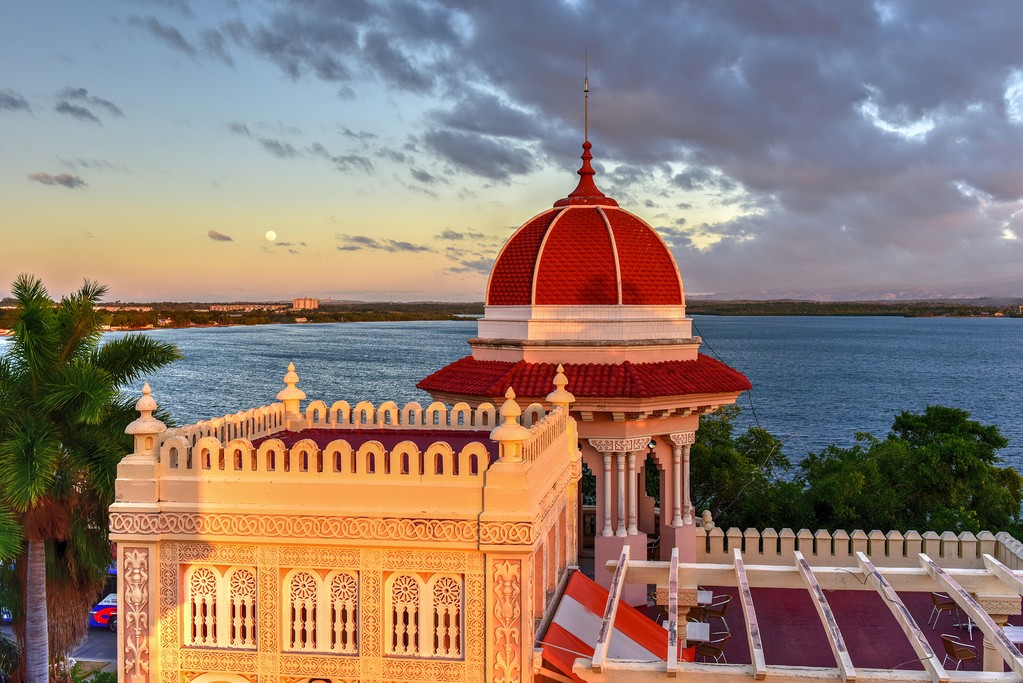
Located three hours southeast of Havana, the peaceful city of Cienfuegos offers a welcome respite from the hustle and bustle of the capital. This city provides a great opportunity to slow down and immerse yourself in the local culture, mingling with friendly Cubans and experiencing their way of life. As the youngest city in Cuba, Cienfuegos was founded in 1819 by French settlers from Louisiana, giving it a unique blend of Cuban and French influences. The city is laid out on the east side of a massive bay and features a distinctly Gallic architectural style in its historic core, earning it the nickname “the Pearl of the South.”
Many of Cienfuegos’ key sites are located on the Parque Martí, the city’s main square, which serves as a vibrant hub of activity. Explore the cathedral, a beautiful example of neoclassical architecture, and the neoclassical Teatro Tomás Terry, a historic theater that hosts a variety of performances. Visit the Museo Histórico Provincial, which offers insights into the city’s rich history and cultural heritage. Take a leisurely stroll along the Malecón and venture to the Punta Gorda peninsula to admire the stunning Palacio del Valle, a former sugar baron’s home built in the Mughal style, showcasing intricate details and opulent design. Architecture and history buffs will also appreciate the Necropolis Tomás Acea, a historic cemetery with elaborate mausoleums, and the Museo Histórico Naval, which explores the city’s maritime history.
Venture outside of town to discover other captivating sites, such as the Castillo de Jagua, a historic fortress that guards the entrance to the bay (take the local ferry for a unique experience), the Jardín Botánico, a lush botanical garden showcasing a diverse collection of plant species, and, if you have extra time, the beach at Rancho Luna, a popular spot for swimming and sunbathing.
#5 Santa Clara
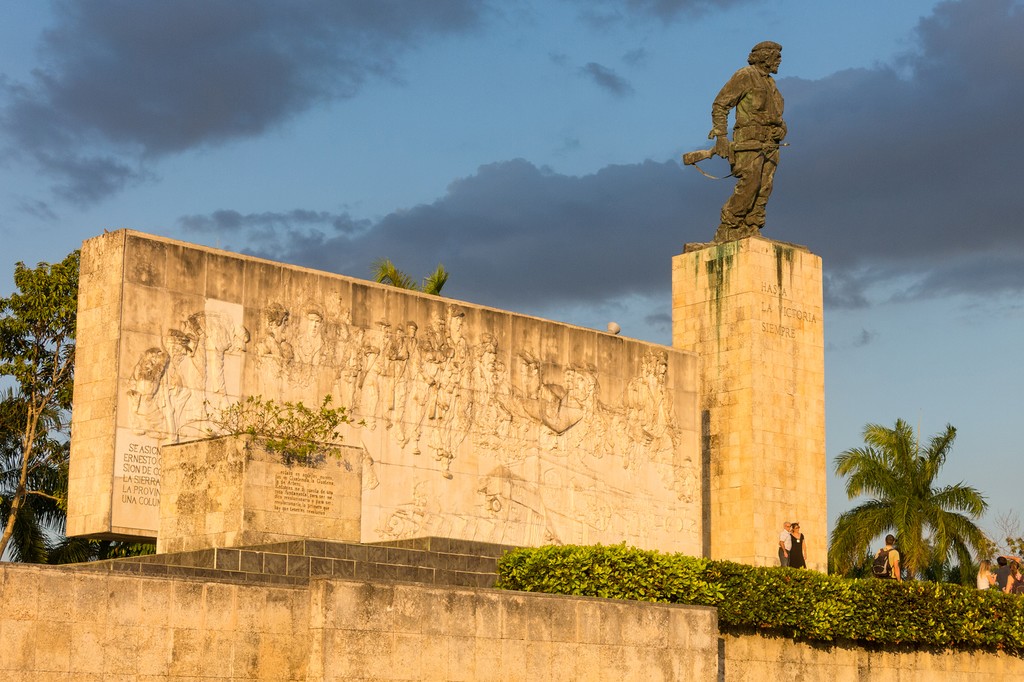
This industrial university city, located four hours east of Havana, will forever be associated with Ernesto ‘Che’ Guevara, the iconic revolutionary figure. It was here, in late December 1958, that Che Guevara led his troops out of the Sierra Escambray and captured the city, a pivotal moment that led to dictator Fulgencio Batista’s fleeing the country. While Santa Clara boasts a lovely historic quarter, most of the sites of interest in this town relate to the revolutionary events that shaped its identity.
The must-not-miss site in Santa Clara is the Complejo Monumental Comandante Ernesto Che Guevara, a massive monument dedicated to Che Guevara that dominates the Plaza de la Revolución. Beneath the monument, explore the superb museum and mausoleum where Che’s remains are interred, offering a poignant and insightful tribute to his life and legacy. Don’t miss the Monumento a la Toma del Tren Blindado, where carriages were strewn haphazardly after Che’s troops derailed a train carrying soldiers and armaments, a symbolic victory that marked a turning point in the Cuban Revolution.
Just a short drive from Santa Clara lie some truly cool places waiting to be discovered. Explore the colonial city of Remedios, a UNESCO World Heritage Site renowned for its well-preserved colonial architecture and charming atmosphere. Relax on the pristine beaches of the Cayos de Villa Clara, a string of islands with some of the best beaches and resort hotels in Cuba.
#6 Trinidad
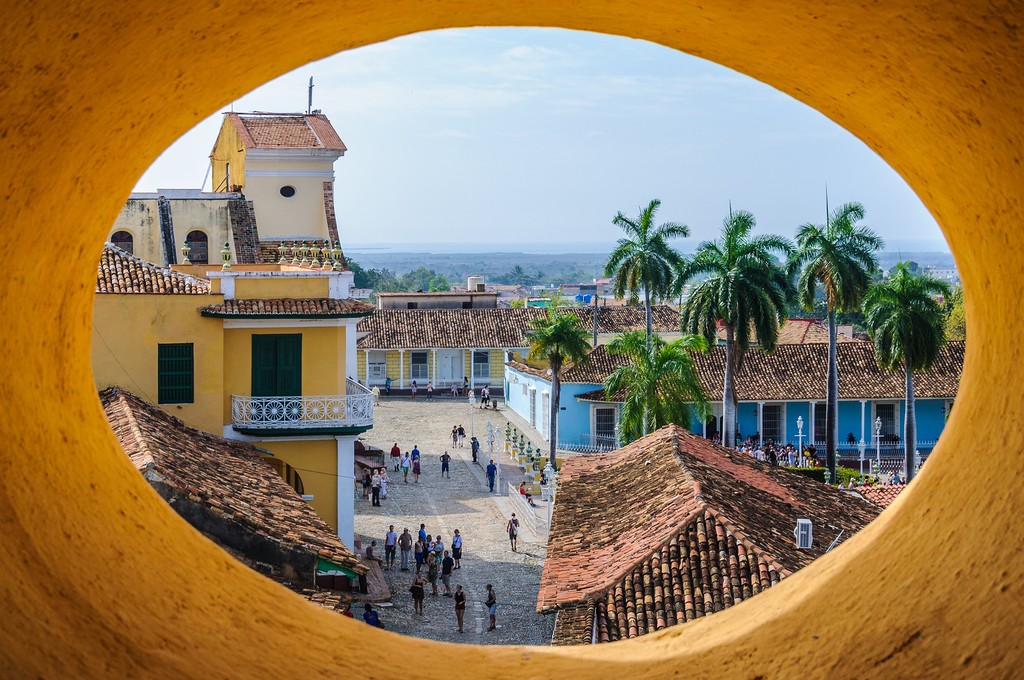
Cuba’s most perfectly preserved colonial city, Trinidad, is a UNESCO World Heritage Site, and justifiably so. Founded in 1514, Trinidad enjoys a superb location on a breeze-swept mountain slope, offering breathtaking views of the Caribbean Sea and the rugged Sierra Escambray.
Most buildings in the cobbled, traffic-free historic core date from the 18th century, showcasing the city’s rich colonial heritage. The most important sites of interest cluster around Plaza Mayor, the heart of Trinidad, with its beautiful cathedral and three museums, including the Museo de Arquitectura Colonial, which provides insights into the city’s architectural evolution. As you wander through the streets of Trinidad, expect to encounter colorful scenes of daily life, from quinceañeras (15-year-old girls) in flouncy dresses celebrating their coming-of-age, to weathered señores on donkeys, and rugged cowboys trotting through town on horseback, adding to the city’s unique charm and character.
Trinidad’s art scene is thriving, with dozens of studio-galleries showcasing the works of local artists. The music and dance scene is equally vibrant, from Afro-Cuban rhythms at the Casa de los Congos Reales to a happenin’ disco inside a cave, offering a unique and unforgettable nightlife experience. Beyond the city limits, you’ll find a wealth of activities to enjoy, from lazing on the beach and scuba diving at Playa Ancón, to hiking in the Sierra Escambray, and horseback rides into the Valle de los Ingenios, once Cuba’s most important sugar-producing valley, replete with historic colonial-era sugar mills.
The only downside to Trinidad’s popularity is that it can get overly crowded with tourists in peak season. However, more than 1,000 homes have rooms for rent, providing ample lodging options for visitors.
#7 Camagüey
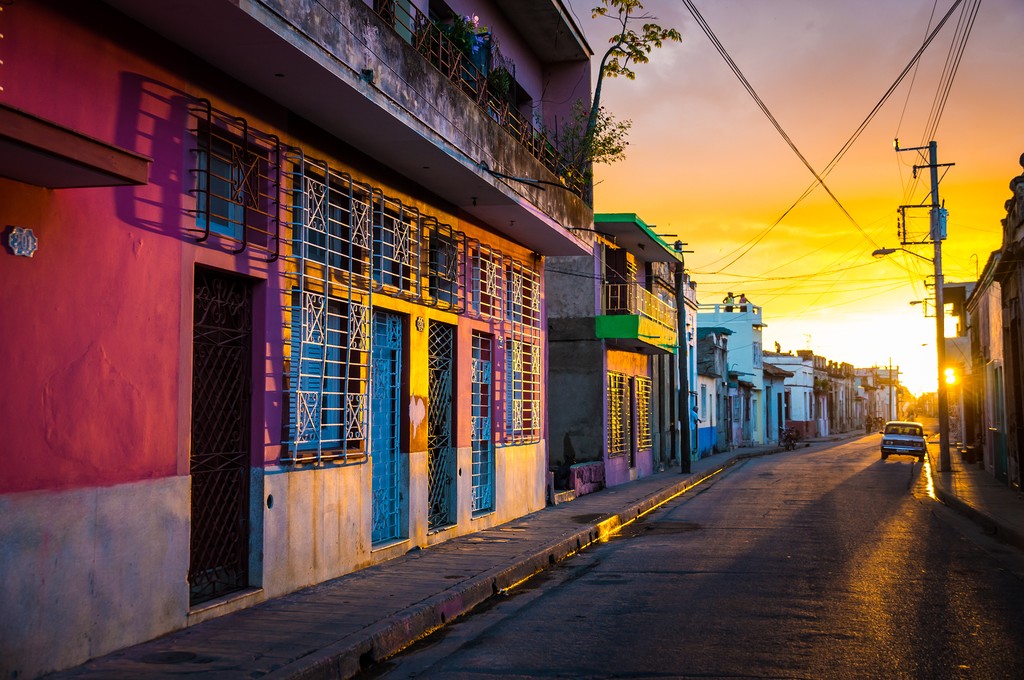
In the very center of the island, Camagüey, Cuba’s third-largest city, is another UNESCO World Heritage Site. Its haphazard historic core is a warren of cobbled colonial plazas, for which it’s known as the “City of Squares.” The town is distinguished by unique architecture, and tinajones: giant earthenware jars used since colonial times to store water. It got a face-lift for the 2014 quincentennial, when several lovely boutique hotels opened their doors. Combine these four main plazas on a walking tour: Parque Agramonte, the main square named for local War of Independence hero Ignacio Agramonte; Plaza del Carmen, with its life-size figures of real locals; Plaza San Juan de Dios, perhaps the most scenic square; and Plaza de los Trabajadores.
The town straddles the Carretera Central, the central highway, and is surrounded by cattle ranches and sugarcane plantations. South of town, nature lovers are drawn to Finca La Belén, a wilderness area in the Sierra del Chorrillo. To the north, Playa Santa Lucía is a second-rate beach resort with world-class scuba diving, while Cayo Romano and Cayo Sabinal are newly emerging as resorts with sensational beaches.
#8 Santiago de Cuba
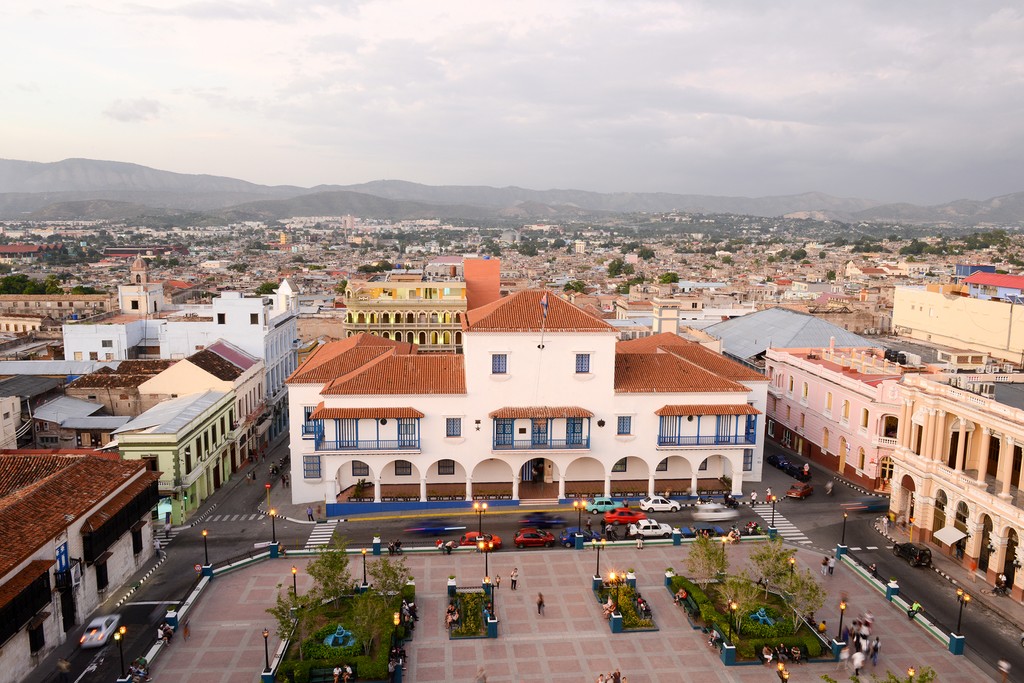
At the far east of the island, Santiago de Cuba, Cuba’s second-largest city, was founded in 1515 as Cuba’s original capital. Surrounded by mountains and sloping gently down to a bay, this hilltop city has a mood all its own. Following the Haitian Revolution in 1791, French settlers (and the enslaved people they brought with them) infused the city with their own architectural, musical, and dance styles. The city is steeped in Afro-Cuban culture and has a wicked nightlife, from son at the island’s top Casa de la Trova to red-hot Carnaval in July.
Its other claim to fame is that the Cuban Revolution was birthed here on July 26, 1953, when Fidel Castro’s revolutionaries attacked the Cuartel Moncada barracks: today, it houses a school and a museum about the event. There are plenty of other historic sites that recall the city’s key role in the Revolution. You’ll want at least one hour to explore Cementerio de Santa Ifigenia, where Fidel Castro and National Hero José Martí top a long list of important figures buried here.
Meanwhile, conquistador Diego Velázquez’s house still stands over Parque Céspedes, the always-bustling main square, lorded over by the Basilica Metropolitana Santa Ifigenia. While exploring the narrow, hilly streets of the Reparto Tivoli and Reparto Los Hoyos historic zones, don’t miss the eclectic Museo Municipal Emilio Bacardí Moreau. History buffs should also head to the city outskirts where you’ll find Parque Histórico La Loma San Juan, the infamous San Juan Hill of Spanish-American War fame, and Parque Histórico El Morro, a castle at the mouth of the bay with a museum on piracy and a nightly firing of a cannon at sunset.
Draws further afield include the Basilica El Cobre, Cuba’s foremost pilgrimage site – and Cayo Granma, in the midst of the bay, is a great place to chill with local fishermen.
#9 Sierra Maestra
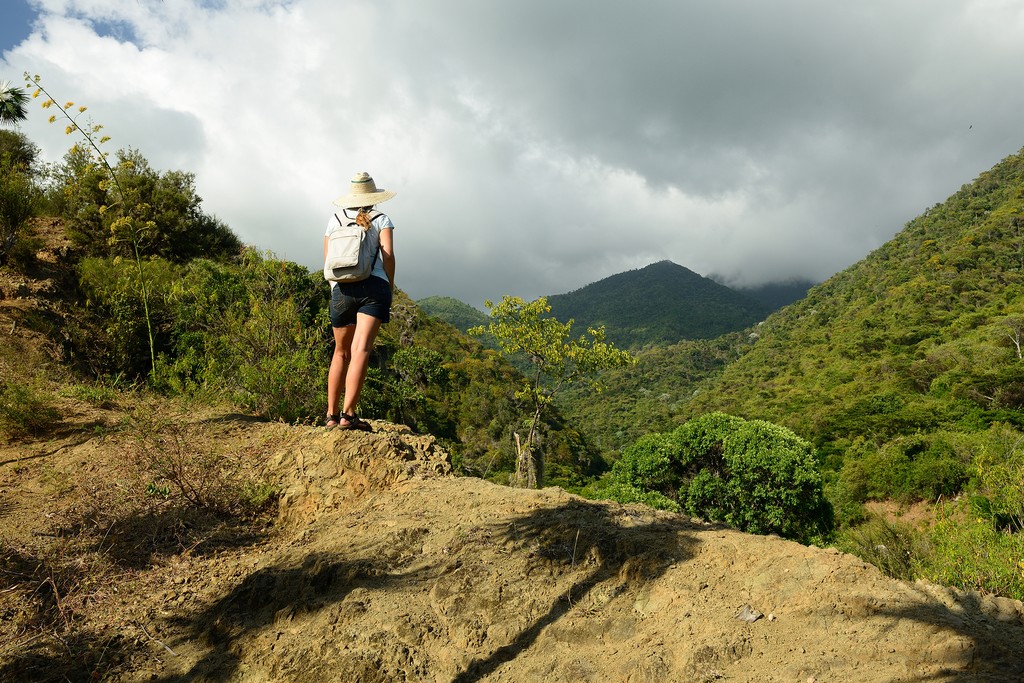
This massive mountain zone runs more or less the length of southeast Cuba and seems to rise vertically from the Caribbean Sea. Most of it has never been trod by foreigners, which makes it all the more alluring. There’s also a historical draw: these mountains were home to the base of Fidel Castro and his Rebel Army from 1956-1958 during the fight to topple Batista.
The two principal reasons to visit are to hike to the summit of Pico Turquino, Cuba’s highest peak at 6,576 feet (1,974 m), and to hike to La Comandancia de la Plata, Fidel’s former guerrilla headquarters, maintained as they were six decades ago high amid the forested mountains.
#10 Baracoa
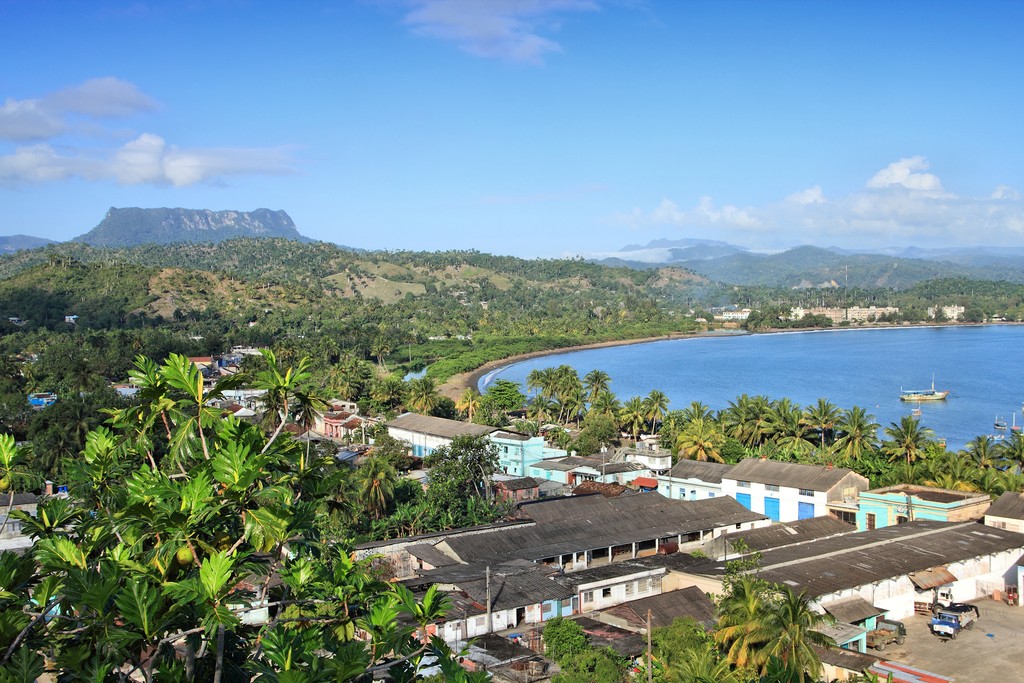
Cuba’s oldest city, founded in 1511, is surrounded by rainforest-clad mountains that include El Yunque, a flat-topped mesa that can be hiked. Reached by a twisting mountain road, the compact town fronts the Atlantic seashore and the Bahía de Miel (Bay of Honey). It appeals primarily for its time-worn wooden buildings and a sense of remove from the rest of the country.
Baracoans claim, unconvincingly, that Christopher Columbus first set foot in Cuba here and left a cross behind, which can be seen in the Catedral Nuestra Señora on Plaza Independencia. Cacao is grown locally (you can visit the plantations), and Baracoa is renowned as Cuba’s center for chocolate production. Most of the surrounding mountains are protected with a series of national parks, tremendous for hiking, and traces of indigenous pre-Columbian culture linger on in Taíno archaeological sites.
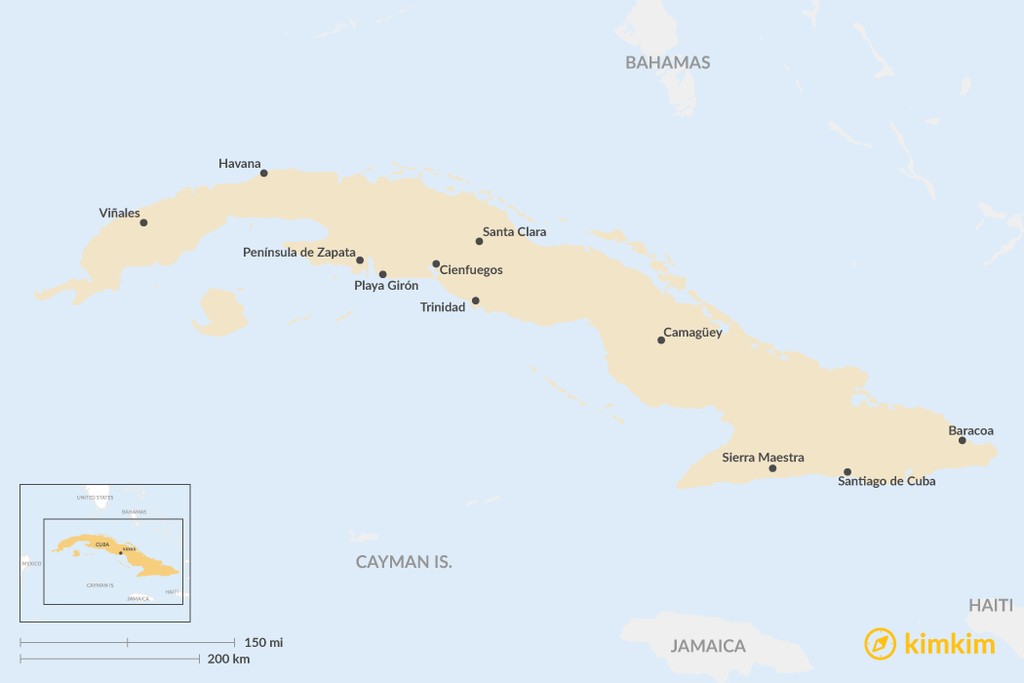
B-674

